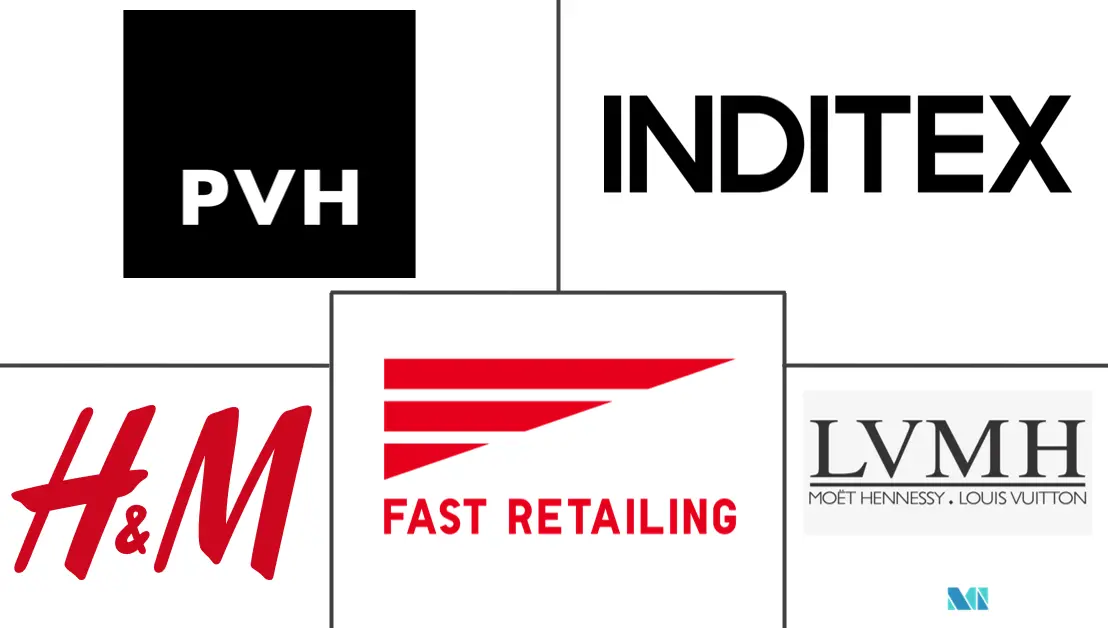Asia-Pacific E-Commerce Apparel Market Size and Share
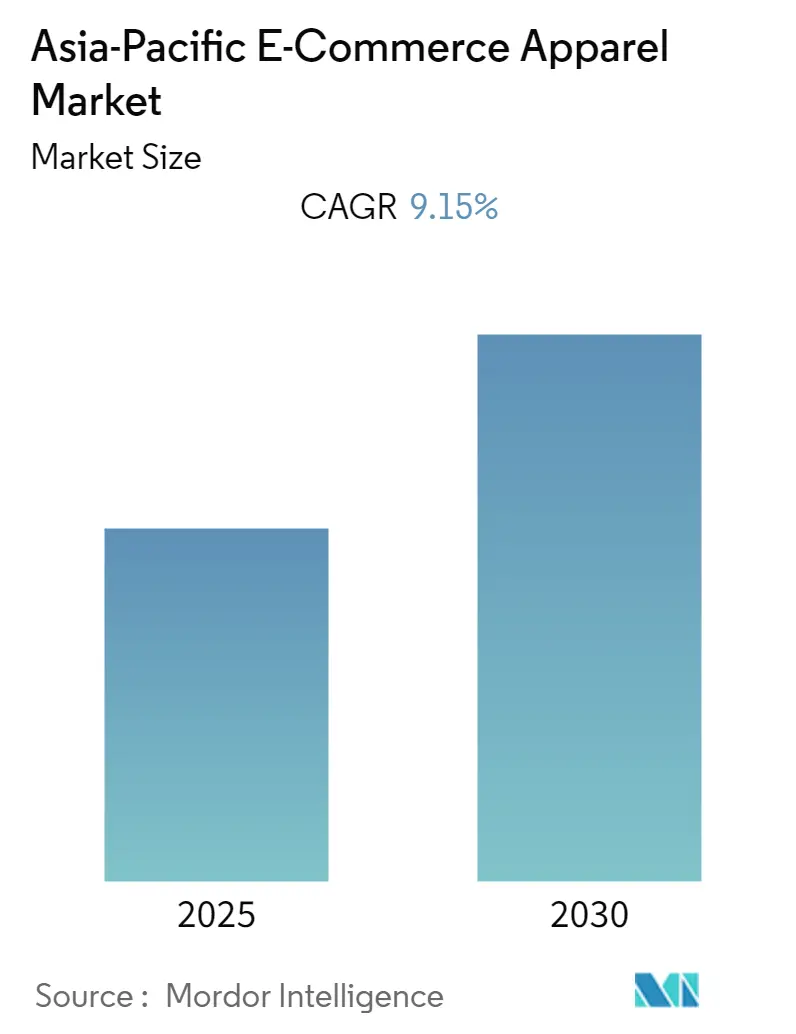
Asia-Pacific E-Commerce Apparel Market Analysis by Mordor Intelligence
The Asia-Pacific E-Commerce Apparel Market is expected to register a CAGR of 9.15% during the forecast period.
- The Asia-Pacific region is being recognized as one of the most significant emerging fashion marketplaces and is gaining popularity. Since the West is already saturated, many companies are shifting their focus to emerging regions, likely to boost the growth of the fashion and apparel sectors here. In addition, Asia has experienced a rapid increase in internet accessibility and penetration, which has sparked the region's subsequent digitization. Therefore, the market's growth in terms of value sales has been assisted by the easy accessibility of these apparel through various sales channels, such as internet stores and direct e-commerce companies.
- Additionally, the growing number of fashion advertisements and marketing initiatives, particularly those featured on the covers of publications like Vogue, Cosmopolitan, and Elle, have boosted plus-size women's self-confidence and contributed to the body positivity trend. For instance, in February 2023, D2C and personalized fashion solutions platform CloudTailor in India announced the launch of its Valentine's Day Social Campaign "Love Your Body, Love Your Fit." The company claims that its campaign is dedicated to promoting body positivity and self-love. Hence, these factors act as major market drivers for the body-positive e-commerce clothing sector.
- Moreover, flash sales prices offered by the e-commerce apparel market also drive the Asia-Pacific e-commerce apparel market since the majority of the customers in this region are price sensitive. For example, November 11th, often known as 11/11, is the busiest day of the year for online shopping in China because it is celebrated as Singles Day. Brands usually generate a large portion of their annual revenue through discounts. This kind of event further attracts consumers to shop online, therefore, increasing the number of online consumers that fuel the nation's E-commerce business.
Asia-Pacific E-Commerce Apparel Market Trends and Insights
Strong Growth of Fashion Marketplaces
- Prominent companies are employing social media tactics to increase their brand awareness and visibility. As a result, these strategies help companies increase revenue. Social media has emerged as one of the most strategic marketing tools. Further, fashion influencers are redefining the industry and are slowly becoming today's modern entrepreneurs, thus driving e-commerce apparel market demand across the region.
- For instance, in June 2023, as part of its 18th Marquee Fashion Festival, which is the end-of-season sale, fashion e-commerce platform Myntra announced the official launch of Myntra Minis, a short-form video platform. The company claims that the newly introduced feature draws inspiration from the popular format of short video clips used by social media platforms to showcase new launches and trends throughout the world and highlights products from various categories.
- In addition, social media enables businesses to connect with an increasing number of social network users and potential target markets. Brands and companies are making use of Instagram and Facebook to appeal to younger audiences through their visual content and advertise their discounts/flash sales to attract customers, thus supporting brand advocacy through impressive, powerful channels. Further, fashion influencers are redefining the industry and are slowly becoming today's modern entrepreneurs, thus driving e-commerce apparel market demand across the region.
- Moreover, celebrity brand endorsements help gain customer attention and trust in the brand. As a result, companies/brands partner with sports athletes, actors, etc. For instance, in March 2023, Online major Parimatch's sportswear brand announced Dinesh Karthik, an Indian cricketer, as its brand ambassador. Therefore, all these factors drive the e-commerce apparel market in the Asia-Pacifc region.
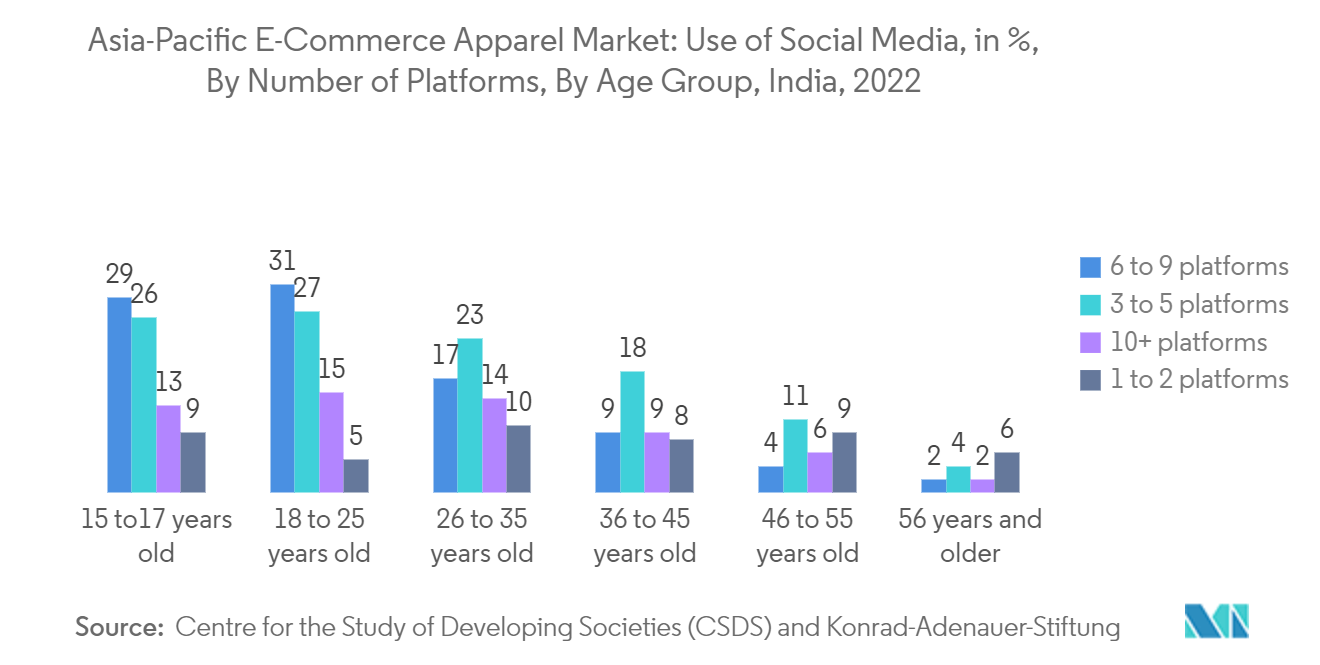
India is the Fastest-Growing Country Across the Region
- In India, many manufacturers of fashion-related products have started selling their products through their websites in addition to third-party online retailers. For instance, in March 2023, Guugly Wuugly, an Indian kids' apparel brand, announced the launch of its new website platform, which allows customers to exchange their children's old clothes for store credit to purchase new products.
- In addition, the company also launched a digital factory outlet where high-quality garments that had minor defects or failed quality checks can be purchased at a discount of up to 40% to 60%.
- Additionally, few government initiatives in this country further boost the sales of the e-commerce apparel market. For instance, in March 2022, the Union Department for Promotion of Industry and Internal Trade in India announced its plans to launch an Open Network for Digital Commerce to democratize e-commerce and bring micro, small, and medium enterprises online. They claim that ONDC uses an open-source methodology to bring buyers and sellers onto a single platform to retail everything from clothing to lifestyle. The initiative has been designed to break the monopoly of e-commerce giants in the Indian online retail market, such e-commerce giants include Flipkart and Amazon, both foreign-owned entities. These initiatives act as major market drivers the small-scale e-commerce apparel companies.
- Also, Myntra has dominated the fashion e-commerce marketplace in terms of share. Myntra, the dominant player in the market, has completely transformed the fashion e-commerce industry. Ajio, which is funded by Reliance, and Tata Cliq, which is owned by Tata, have been able to establish a solid presence with a steadily increasing market share over the past few years. All markets are competing for customers' attention and fostering brand loyalty. Indian fashion e-commerce is a sizable market with the potential for numerous marketplaces to co-exist and develop their respective industries.
- Further, the expansion of Internet and smartphone use in India is another element boosting the country's online fashion retail business. According to data given by the Telecom Regulatory Authority of India (TRAI) in August 2021, the total number of internet users in India increased from 795.18 million at the end of December 2020 to 825.30 million at the end of March 2021.
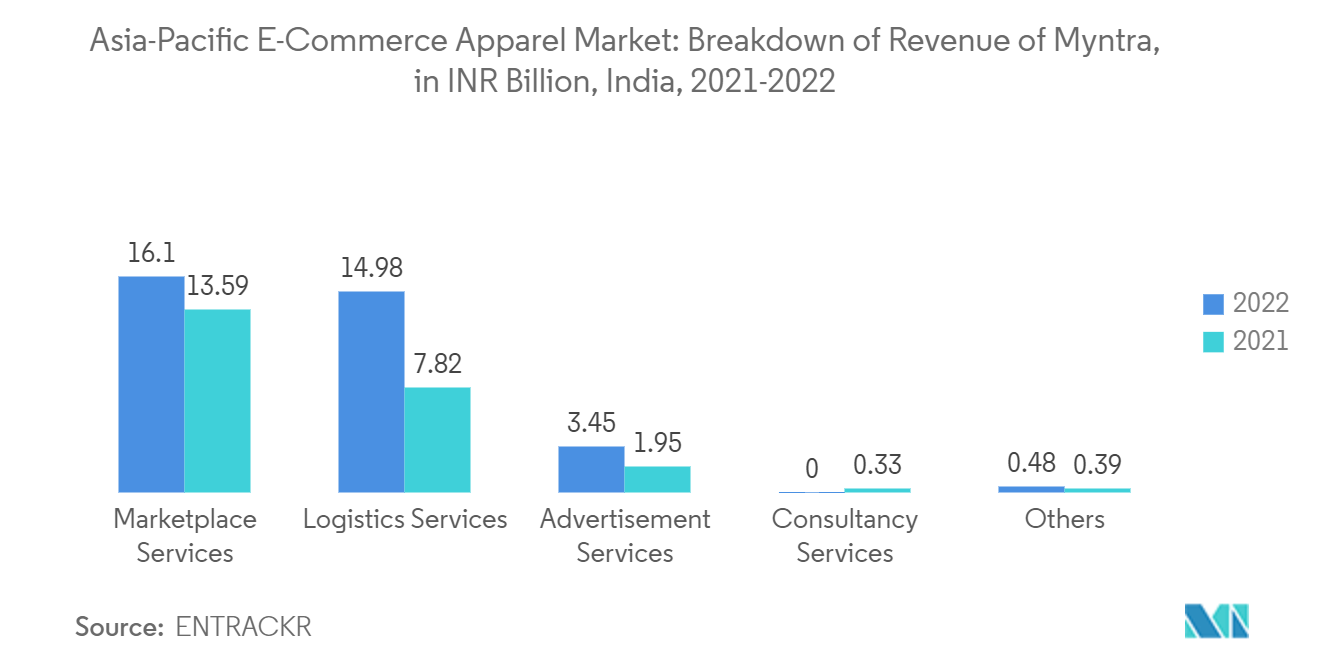
Competitive Landscape
The Asia-Pacific E-Commerce Apparel Market is highly competitive owing to the presence of multiple regional and multinational companies offering a wide range of online apparel products and trying to maintain their leadership position in the market studied. Major players in the market include PVH Corp., Inditex, Hennes & Mauritz AB, Fast Retailing Co., Ltd., and LVMH Moët Hennessy Louis Vuitton, each of which holds a significant share of the market studied.
These players have been undertaking business strategies, including product innovations, partnerships, strengthening their hold over online and offline marketing, and mergers and acquisitions to expand their visibility and portfolio of offerings, thus, augmenting the growth of the market. Further, the companies have been introducing new and innovative products with the inclusion of sustainable raw material fabrics to make their product unique from the existing products. Owing to the rapidly developing nature of the market, new product innovation has become the most commonly used strategy among all.
Asia-Pacific E-Commerce Apparel Industry Leaders
PVH Corp.
Inditex
Hennes & Mauritz AB
Fast Retailing Co., Ltd.
LVMH Moët Hennessy Louis Vuitton
- *Disclaimer: Major Players sorted in no particular order
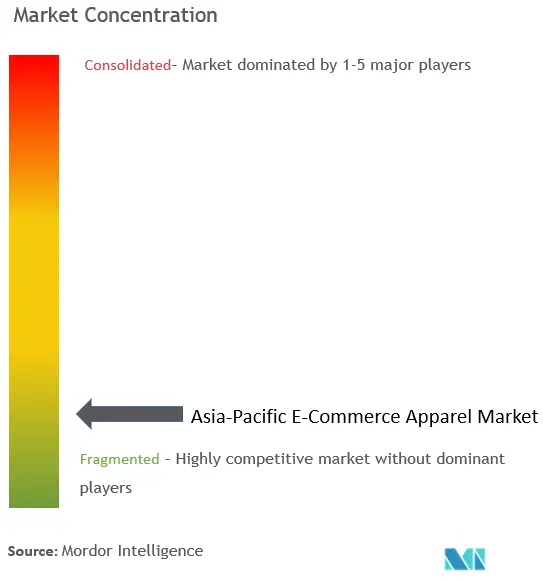
Recent Industry Developments
- May 2023: Alessandro Vittore, a United Kingdom-based clothing company, announced its plans to launch the brand in Indian Market.
- March 2023: In Japan, UNIQLO announced its collaboration of Attack on Titan with its UT brand for a brand new slate of t-shirts. The company claims to offer seven new designs, with online orders consisting of a custom box that features scenes from the manga.
- March 2023: Italian Colony announced the launch of its online store in India and claims to provide affordable Italian fashion to Indians. The company also claims that the online store currently offers a range of men's pants, including joggers, cargo, jeans, and trousers.
- February 2023: Forever 21 announced its relaunch in Japan as an upscale clothier. The company claims that it aims to localize the brand by size, color, and design. Further, they also state that around 80% of Forever 21s new collection would be launched in the fashion-crazy country via online sales and a pop-up store in central Tokyo.
Asia-Pacific E-Commerce Apparel Market Report Scope
E-Commerce apparel includes the buying and selling of fashion and apparel products online, specifically through e-commerce platforms.
The Asia-Pacific e-commerce apparel market is segmented by product type, end-user, platform type, and geography. Based on product type, the market is segmented into formal wear, casual wear, sportswear, nightwear, and other types. Based on end users, the market is segmented into men, women, and kids/children. Based on platform type, the market is segmented into third-party retailers and the company's own website. The study also covers the analysis of major regions, such as China, Japan, India, Australia, and the Rest of Asia-Pacific.
The market sizing has been done in value terms in USD for all the abovementioned segments.
| Formal Wear |
| Casual Wear |
| Sportswear |
| Nightwear |
| Other Types |
| Men |
| Women |
| Kids/Children |
| Third Party Retailer |
| Company's Own Website |
| China |
| Japan |
| India |
| Australia |
| Product Type | Formal Wear |
| Casual Wear | |
| Sportswear | |
| Nightwear | |
| Other Types | |
| End User | Men |
| Women | |
| Kids/Children | |
| Platform Type | Third Party Retailer |
| Company's Own Website | |
| Geography | China |
| Japan | |
| India | |
| Australia |
Key Questions Answered in the Report
What is the current undefined size?
The undefined is projected to register a CAGR of 9.15% during the forecast period (2025-2030)
Who are the key players in undefined?
PVH Corp., Inditex, Hennes & Mauritz AB, Fast Retailing Co., Ltd. and LVMH Moët Hennessy Louis Vuitton are the major companies operating in the undefined.
What years does this undefined cover?
The report covers the undefined historical market size for years: 2019, 2020, 2021, 2022, 2023 and 2024. The report also forecasts the undefined size for years: 2025, 2026, 2027, 2028, 2029 and 2030.
Page last updated on:
Asia-Pacific E-Commerce Apparel Market Report
Statistics for the 2025 Asia-Pacific E-Commerce Apparel market share, size and revenue growth rate, created by Mordor Intelligence™ Industry Reports. Asia-Pacific E-Commerce Apparel analysis includes a market forecast outlook for 2025 to 2030 and historical overview. Get a sample of this industry analysis as a free report PDF download.
